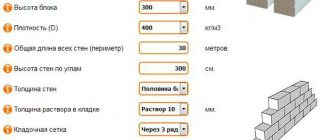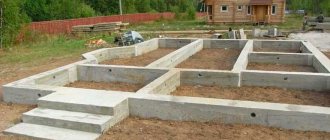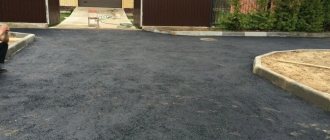When laying any road, you need to start by calculating the amount of building materials required. First of all, this is the calculation of asphalt as the main expense item, both in financial and purely utilitarian terms. The most convenient unit of measurement in this context when ordering this material is ton. To calculate the number of cubic meters required for a road, you also need to convert cubic meters into tons, since consumption is calculated based on mass.
The purchase of asphalt is based on how many m3 fits in the KamAZ. At the same time, there is no standard asphalt mixture, that is, with the same volume we get different masses. To avoid a long and tedious search for conversion factors for asphalt from m3 to tons, you can turn to the help of our website.
An online calculator specially created for these purposes will help you find out exactly how many cubic meters are in a ton of asphalt and vice versa. Thanks to this, it is possible to create an estimate that complies with legal and regulatory standards and prevents cost overruns. And knowing how much a cube of asphalt weighs in tons, you can accurately calculate the required amount for the required area.
Asphalt consumption per m2 with a layer thickness of 1 cm
Our many years of experience have given us the opportunity to formulate a clear action plan and identify average asphalt consumption values per 1 m2. We did this to facilitate our work and to conveniently calculate asphalt consumption by the customer.
Asphalt consumption per 1 m2 with a layer thickness of 1 cm:
- fine grain raft. type A m I - 25.7 kg.
- fine grain raft. type B m I, m II - 24.6 kg.
- fine grain raft. type B m II - 24.9 kg.
- sand raft type G m II - 25.0 kg.
- sand raft type D m II - 23.2 kg.
- fine-grained pore. m I, m II - 24.8 kg.
- coarse-grained pore. m I, m II - 24.2 kg.
- crushed stone-mastic-15 - 25.8 kg.
- crushed stone-mastic-20 - 25.7 kg.
We can conclude that the approximate consumption of asphalt per 1 sq.m. with a layer thickness of 1 cm it is equal to 25 kg. That is, when paving in 1 layer according to GOST thickness. 4-5 cm, you will need 100-125 kg of asphalt.
Calculation of material consumption
In order to correctly calculate the consumption of asphalt concrete during asphalt paving , you need to know the total area of the territory, thickness. layer and type of mixture. The type of mixture can be determined after a free visit from our engineer.
Calculation example for clarity
For example, we have an area of 1000 m2, and we need to perform asphalting with a thickness of H=5 cm:
1) 25.7 kg * 4cm = 102.8 kg - the number of m/z of dense asphalt mixture type A m I, for 1 m2 of asphalt laying.
2) 0.103 t * 1000 m2 = 103 tons - the amount of asphalt concrete required for paving the territory.
The amount of asphalt given in the calculations that is required to lay 1 cm of asphalt pavement is approximate. To prepare an estimate, you need to call a competent specialist who will correctly calculate all costs based on your property. You can do this by contacting our company at +7 (903) 719-17-75 or leaving a request on the website. We will come to you free of charge and advise you on the spot!
On consumption standards for asphalt concrete mixtures in the new SNB-2017
Problematic issues in the NSS 2017
No price for cutting asphalt concrete pavement of types A and B grade I on crushed igneous rocks
As part of the State elemental estimate standards for construction and special construction work as amended in 2014, approved by order of the Ministry of Construction and Housing and Communal Services of the Russian Federation dated January 30, 2014 No. 31/pr, and entered into the Federal Register of Estimate Standards by order dated February 1, 2014 No. 181, there are standards:
— Table GESN 27-03-013 “Cutting the surface layer of asphalt concrete type A and B grade I on crushed stone of igneous rocks grade of crushability 1000 MPa or more, abrasion resistance I1 with profile leveling to the mark using imported road milling machines with a drum width of 2000-2100 mm” ;
— Table GESN 27-03-014 “Cutting a coating of asphalt concrete type A and B grade I on crushed stone of igneous rocks grade of crushability 1000 or more MPa abrasion I1 with local maps of imported road milling machines with a drum width of 1000 mm” (see GESN 81-02 -27-2001 Part 27 “Highways”).
The appearance of these standards in the estimate and regulatory framework was the result of a large two-year research work of several research teams and a number of road construction enterprises, carried out in full compliance with the then-current “Procedure for the development and approval of standards in the field of estimate regulation and pricing in the field of urban planning activities”, approved by Order of the Ministry of Regional Development of the Russian Federation dated April 11, 2008 No. 44.
These standards most fully reflect the costs of all resources for cutting asphalt concrete pavements on crushed stone from durable igneous rocks
rocks of crushability grade 1000 or more MPa, abrasion resistance I1, and take into account all the differences from cutting road asphalt concrete pavements on crushed stone from
sedimentary
rocks.
When forming the estimate and regulatory framework in the 2022 edition (see GESN 81-02-27-2017 Collection 27 “Highways”), tables GESN 27-03-013 and GESN 27-03-014 are excluded from the current standards.
In this connection, the question arises, for what reasons are reasonable prices excluded, and cutting asphalt concrete on crushed stone from durable igneous rocks of a crushability grade of 1000 MPa or more, abrasion resistance I1, the difficulty of developing which is 2.5-3 times higher, should be standardized according to the standard, designed for cutting road asphalt concrete pavements on crushed stone from sedimentary rocks?
It is necessary to include in the estimate and regulatory framework of the 2022 edition the tables GESN 27-03-013 and GESN 27-03-014, which were previously included in the federal register of estimate standards as part of the 2014 edition of the National Security Council.
Inaccuracy of standards for laying asphalt concrete mixtures in SNB-2017
Standards table GESN27-06-029(030)
first released in 2007 (“Changes and additions to the GESN for construction work. Issue 4”, Rosstroy, Moscow 2007) and were called “Construction of a 4 cm thick pavement from hot asphalt concrete mixtures using the Titan-325 asphalt paver and the Shuttle loader -Buggy SB-2500С.” The standards were developed on the basis of the TTK for “Construction of the bottom layer of asphalt concrete pavement” and are fully consistent with ODM 218.5.002-2009 “Methodological recommendations for the construction of asphalt concrete layers using mixture loaders”, take into account the compaction of the asphalt concrete mixture by a group of four rollers, one of which is pneumatic, in full compliance with clause 5.7 “Manuals for the construction of asphalt concrete pavements and foundations of highways and airfields (to SNiP 3.06.03-85 (SP 78.13330.2012) and SNiP 3.06.06-88 (SP 121.13330.2012)), where indicated , that “... compaction of dense and porous asphalt concrete mixtures must be carried out by a team of at least 3 rollers (7 tons, 10 tons and 14 tons), one of which is pneumatic."
The standards of the table GESN27-06-029(030) as amended in 2014 were developed for the construction of pavements from hot coarse-grained, fine-grained, sandy dense or porous asphalt concrete mixtures using modern asphalt paving equipment complexes and take into account the resource within the price: Asphalt concrete mixture, the consumption of which is determined differentially depending on type of mixture and density of stone materials. The 2014 edition was included in the federal register of estimate standards as part of the National Security Council as No. 122 by order of the Ministry of Construction of Russia dated January 30, 2014 No. 31/pr.
Since in the 2022 edition the quantitative values of the standards for EMM have not changed, there is reason to believe that the same type of asphalt paver is meant as in 2007 (and in 2014), the laying width of which is up to 10 m, and not 2.0-5, 0m, as indicated in the 2022 standard.
Standards of the table GESN 27-06-031(032)
were originally developed to determine the cost of a SMA coating device. The set and technical parameters of the equipment taken into account by the standards of GESN 27-06-031(032), the number of machine-hours of its use fully corresponds to the technological maps for the installation of pavement only from crushed stone-mastic asphalt concrete (type ShchMA-10, ShchMA-15, ShchMA-20, ShMA-30). The standards take into account the compaction of the SMA layer: - rolling in 2-4 passes of a light roller, weighing from 4.5 to 7.3 tons, and rolling in 4-8 passes of a medium roller, weighing from 7.1 to 10 tons, which in no way corresponds to ( not enough) requirements for compacting dense and porous asphalt concrete mixtures, especially those laid with wide-spread asphalt pavers.
The application of the standards of table GESN 27-06-031(032) to determine the cost of installing base and coating layers from coarse-grained and fine-grained porous and dense asphalt concrete mixtures is technologically incorrect and contradicts the regulatory documentation (SP 78.13330.2012). In accordance with clause 5.7 of the Manual for the construction of asphalt concrete pavements and foundations of highways and airfields (to SNiP 3.06.03-85 (SP 78.13330.2012) and SNiP 3.06.06-88 (SP 121.13330.2012)), compaction of dense and porous asphalt concrete mixtures must be produced by a squad of at least 3 rollers (7 tons, 10 tons and 14 tons), one of which is pneumatic, and the total number of roller passes along one track is required from 19 to 23, which is provided for by the standards of the GESN 27-06-029 tables ( 030).
We consider it necessary in the name of the standards of the table GESN 27-06-031(032) to replace the words “Construction of pavement from hot asphalt concrete mixtures using imported asphalt pavers of the third and fourth standard sizes” with the words “Construction of pavement from crushed stone-mastic asphalt concrete mixtures.”
On consumption standards for asphalt concrete mixtures in the new SNB-2017
The standards of tables GESN27-06-029(030) and GESN 27-06-031(032) provide for the consumption of asphalt concrete mixtures to be determined based on design data. In the absence of design data in accordance with paragraph 1.27.35 of the General Provisions, consumption rates can be adopted according to Appendix 27.1.
The values for the consumption rates of the asphalt concrete mixture in Appendix 27.1 were taken from the 1984 estimate and regulatory framework for Table 27-06-020(021) with an interval for the density of stone materials from 2.5 t/m3 to 2.9 t/m3, which is incorrect, because In different regions, the availability of types of stone materials varies.
Averaged recommended norms, without an expanded range of selection of their values, can lead to a decrease in the quality of the asphalt concrete pavement (reducing the layer thickness during laying to avoid overconsumption of the asphalt concrete mixture).
Appendix 27.1. “Consumption rates for asphalt concrete mixtures” need to be developed in a more differentiated manner, indicating the consumption rates of asphalt concrete depending on the true density of stone materials and highlighting mixtures with the density of stone materials:
— 2.5 — 2.7 t/m3
— 2.7 — 2.9 t/m3
— more than 2.9 t/m3
At the same time, in addition to physical and mechanical indicators (density of stone materials, density of a/c mixture, compaction coefficient), consumption standards must take into account difficult to eliminate losses of the mixture during transportation and installation.
We propose that Appendix 27.1 of GESN 81-02-27-2017 be presented as follows:
| (Appendix 27.1 GESN 81-02-27-2017) | ||||||||
| Consumption rates of hot asphalt concrete mixture per 1000 m2 | ||||||||
| Item no. | Name and type of mixture | Unit. | at the density of stone materials: | |||||
| 2.5 - 2.7 t/m3 | 2.7 - 2.9 t/m3 | more than 2.9 t/m3 | ||||||
| layer 4 cm | +/- 0.5cm | layer 4 cm | +/- 0.5cm | layer 4 cm | +/- 0.5cm | |||
| graphs | 1 | 2 | 3 | 4 | 5 | 6 | ||
| 1 | Hot dense fine-grained asphalt concrete road mixture, type ABV, grades I, II | __ton__ 1000 m2 | 98,26 | 12,28 | 105,20 | 13,15 | 108,88 | 13,61 |
| 2 | Hot dense coarse-grained asphalt concrete road mixture, type ABC, grades I, II | __ton__ 1000 m2 | 98,00 | 12,25 | 104,96 | 13,12 | 108,48 | 13,56 |
| 3 | Hot dense sand asphalt concrete road mixture, type GD, grades I, II | __ton__ 1000 m2 | 90,16 | 11,27 | 96,48 | 12,06 | 103,68 | 12,96 |
| 4 | Hot porous fine-grained asphalt concrete road mixture, grades I, II | __ton__ 1000 m2 | 90,80 | 11,35 | 97,92 | 12,24 | 103,28 | 12,91 |
| 5 | Hot porous coarse-grained asphalt concrete road mixture, grades I, II | __ton__ 1000 m2 | 90,56 | 11,32 | 97,76 | 12,22 | 103,04 | 12,88 |
| 6 | Hot high-density fine-grained asphalt concrete road mixture, type ABV, grades I, II | __ton__ 1000 m2 | 99,36 | 12,42 | 106,32 | 13,29 | 110,00 | 13,75 |
| 7 | Hot high-density coarse-grained asphalt concrete road mixture, type ABC, grades I, II | __ton__ 1000 m2 | 99,28 | 12,41 | 106,24 | 13,28 | 109,92 | 13,74 |
| 8 | Hot, highly porous, fine-grained asphalt concrete road mixture, grades I, II | __ton__ 1000 m2 | 87,92 | 10,99 | 91,60 | 11,45 | 97,92 | 12,24 |
| 9 | Mixture of asphalt concrete road hot, highly porous, coarse-grained, grades I, II | __ton__ 1000 m2 | 83,52 | 10,44 | 89,76 | 11,22 | 96,00 | 12,00 |
| 10 | Crushed stone-mastic asphalt concrete mixtures (SCMA) | __ton__ 1000 m2 | 97,84 | 12,23 | 105,60 | 13,20 | 108,80 | 13,60 |
| 11 | ||||||||
About the reduction factor k=0.4 on the BNS
According to the letter of the Ministry of Regional Development No. 30424-КК/08 dated August 20, 2010 “on the use of indices for changes in the estimated cost of construction and installation work” and explanations in letters:
No. 39988-КК/08 dated November 26, 2010. and No. 5623-EC/08 dated 04/07/2014. (included in the federal register of estimate standards - see clauses 4, 10, 76) to determine the cost of installing bored piles (BPS) according to FER (TER) prices 05-01-075-01÷05-01-080-07 part 5 collection “Piling works” a reduction factor K = 0.4 is applied when recalculating to the current price level.
Prices FER (TER) 05-01-075-01÷05-01-080-07 of part 5 of the collection “Pile works” do not take into account reinforcement cages and ready-mixed concrete. Their cost is determined based on design data in accordance with GESN and is taken into account in the estimates as separate lines. Accordingly, letter No. 30424-КК/08 dated August 20, 2010 does not apply to lines that take into account the cost of reinforcement frames and concrete. Until June 2014, the coefficient was applied correctly.
By letter dated June 20, 2014 No. 615-20449/ФЦ (not included in the federal register of estimate standards), Head of the Federal Pricing Center E.E. Ermolaev incorrectly explained the procedure for applying the above coefficient and unreasonably indicated that K = 0.4 applies not only to prices
FER (TER) 05-01-075-01÷05-01-080-07, but
also to the cost of reinforced frames and ready-mixed concrete, in violation of
clause 2.2. MDS 81-35.2004, which states that “estimated standards are the minimum necessary and sufficient to perform the corresponding type of work... and standards are not adjusted towards their reduction.”
The application of a reduction factor K=0.4 to the cost of materials not taken into account in the price (reinforcement frames, concrete) reduces the cost of these materials by 60% compared to the market average, thus the Contractors' costs for the purchase of these materials significantly exceed the estimated cost taking into account K= 0.4.
Please cancel letter No. 615-20449/FC dated June 20, 2014 and give
a correct explanation of the procedure for applying the specified reduction factor, namely:
— the coefficient is not used in estimates at the basic price level. Limited costs at the basic price level are accrued from the total cost of work on the construction of the BPS (without K = 0.4);
— the coefficient is applied only when recalculating to the current price level and only to direct costs of closed complex prices FER (TER) 05-01-075-01÷05-01-078-07 part 5 of the collection “Piling works”;
— the coefficient does not apply to the cost of concrete and reinforcing frames, the consumption of which is not taken into account in the indicated prices, but is determined on the basis of the State Electrical Energy System according to design data and is taken into account as separate lines in the estimate;
— to clarify the cost of reinforcement frames and ready-mixed concrete, a market analysis can be carried out based on specific commercial offers from suppliers. Analysis data can be included in the estimate with reduction to the basic price level by reverse counting.
In connection with the delay in the introduction of the resource method for determining the cost of construction until the start of the full operation of the Federal State Information System of Pricing in Construction until September 2022, we ask for clarification on the issue of applying K=0.4 due to the impossibility of fulfilling contractual obligations due to a significant underestimation of the estimated cost materials.
On cost standards for temporary buildings and structures
1) Due to the fact that there are cases of substitution of the concept of “temporary signs” with the organization of traffic during the period of work, we ask you to make an addition to the Collection of estimated cost standards for the construction of temporary buildings and structures GESN 81-05-01-2001 section 1. “General provisions” clause 1.6 in the text part and stated as follows:
“The estimated standards for the construction of title temporary buildings and structures do not take into account the costs of:
— payment for land, allotment and preparation of territory for the construction of temporary buildings and structures, including drainage, filling or alluvium, reclamation, restoration of water use conditions, clearing of forests and organization of road traffic during the period of work
(provided for in Chapter 1 “Preparation of the construction site” of the summary estimate for the construction as a whole, taking into account the placement of temporary buildings and structures).”
2) The list of costs not taken into account by the estimated standards can be supplemented on the basis of the construction organization project (POS). Since such a text is prescribed in GESN 81-05-01-2001 (section 1 clause 1.7) and each case and the POS itself is individual in each case, it seems that this is sufficient for calculating the estimated cost of construction of the facility.
3) In part of Section 2 “Procedure for application of norms” we consider it necessary to supplement the second paragraph of clause 2.1 and state it in the following wording:
“When drawing up estimate documentation for major repairs of industrial buildings, reconstruction and expansion of existing enterprises, buildings and structures, construction of subsequent phases on the territory of existing enterprises or adjacent sites, a coefficient of 0.8 is applied to the specified standards if the cost of the object is determined by repair standards ( GESNr) or subject to the reduction of construction prices (according to clause 4.7 of MDS 81-35.2004) to the conditions of repair and reconstruction prices using coefficients of 1.15 and 1.25
».
The need for this is due to the fact that experts often force the use of a coefficient of 0.8, guided only by the title of the object, while according to the same concept they do not skip the application of k = 1.15 and 1.25 (clause 4.7 of MDS 81.35-2004), which distorts the summary estimate.
4) The most problematic issue that is currently being resolved by Customers in violation of existing provisions is the return of materials.
Despite the fact that with the introduction on March 9, 2004 MDS 81-35.2004 “Methods for determining the cost of construction products on the territory of the Russian Federation (Resolution of the State Construction Committee of Russia dated 03/05/2004 No. 15/1) Code of rules for determining the cost of construction as part of pre-design and design - estimate documentation SP-81-01-84, according to clause 13.6.6 of which it was necessary to include in the estimate documentation refundable amounts taking into account the cost of materials and parts obtained from dismantling temporary buildings and structures, has become invalid
, FAU "Glavgosexpertiza of Russia", in violation of MDS 81-35.2004, continues to accept for consideration projects with the mandatory inclusion of refundable amounts in the amount of the specified 15%.
Further, ignoring clauses 4.12, 4.36, 4.100.1 MDS 81-35.2004, Customers consider these “reference” amounts as mandatory exclusion from contracts, thereby initially underestimating the cost of construction and, accordingly, the amount of taxes transferred.
There is hardly an example where (as recommended in clause 3.6 of GSN 81-05-01-2001) returnable materials “are received by the Customer’s accounting department and sold to the Contractor with his consent.”
The indicator “15%” of the cost of expenses under the item “Temporary buildings and structures” was at one time calculated and averaged at fixed prices. Currently, it is impossible to calculate a value specific to all regions, even if we use an outdated calculation model, because The price range for materials is large. In addition, many price indicators have grown unevenly since 1984, with ongoing inflation. Moreover, there cannot be any specific indicator. It should also be borne in mind that the return from dismantling temporary buildings and structures was determined in civil and industrial construction, which is not entirely suitable, for example, for road and bridge work. It is known that even quarterly inflation indices are divided into industrial and civil construction, and separately “other objects”, by which the cost of road work is determined.
Taking into account the above, it seems that there cannot be a specific standard for refundable amounts. An engineering project cannot specify repayable amounts and designate them as dogma. It is not for nothing that the concept of “for reference” has always existed and been enshrined. When implementing any investment project, work that is no longer required, or new types of work, etc. arise. It is possible that those from whom the return of materials is calculated will no longer be available. How can you exclude them from the beginning, especially when concluding contracts?
The return of materials, if any, must be carried out on the basis of acts signed by all interested parties in the prescribed manner and in accordance with the requirements of MDS 81.35-2004 through the posting of the Customer's accounting department. And a deliberate initial reduction in the value of the contract, and, accordingly, an underestimation of the tax base, is considered illegal.
5) Currently, the regulatory framework does not contain regulations on “bringing returnable materials into a suitable condition.”
It is known that when concluding contracts, one of its clauses specifies the use of certified materials in the implementation of the project. It is unclear who should determine the suitability of returnable materials and certify them so that the disassembled materials can be used at another publicly funded facility.
At a minimum, an estimate must be drawn up to bring the material into a suitable condition. It is unclear who should check and approve this estimate. Determining the suitability of a material for further use was possible when there were fixed prices for materials, and the same bringing into a suitable condition was calculated for different types of work. For example, in St. Petersburg (Leningrad), prices for granite side stones for reuse on site were approved. The cost of bringing it into a suitable condition was excluded from the price of the new stone. The estimates took into account the new costs of these stones. Today, no one believes that when rearranging granite side stones, the disassembled ones should be cleaned of the concrete “coat”, and chips, if any, should be plastered. This is additional, and, as a rule, manual work that is not taken into account in the estimate. The customer accepts the work of rearranging the side stones simply with a zero price, which is wrong.
We believe that while regulations for bringing materials into a suitable state have not been developed, it is incorrect to use such terminology.
6) We consider clause 4.100.1 of MDS 81.35-2004 to be a controversial issue regarding returnable materials, which states the following “... minus the costs of bringing them into a suitable condition and delivering them to storage places.”
For example, wood felling work. In the local estimate, the yield of commercial and firewood, valuable returnable material that is moved after felling and skidding no further than 300 meters, is determined and assessed. Is it possible to leave it every day without delivering it to a secure warehouse? Can the Customer, whose material this is, pick it up himself every day of felling and move it to his protected site? Experience shows that absolutely not. Therefore, adjustments must be made to the regulatory documents and the text stating that the delivery of returnable material to storage areas must be excluded. On the contrary, such materials must immediately and without fail be moved to a secure warehouse.











